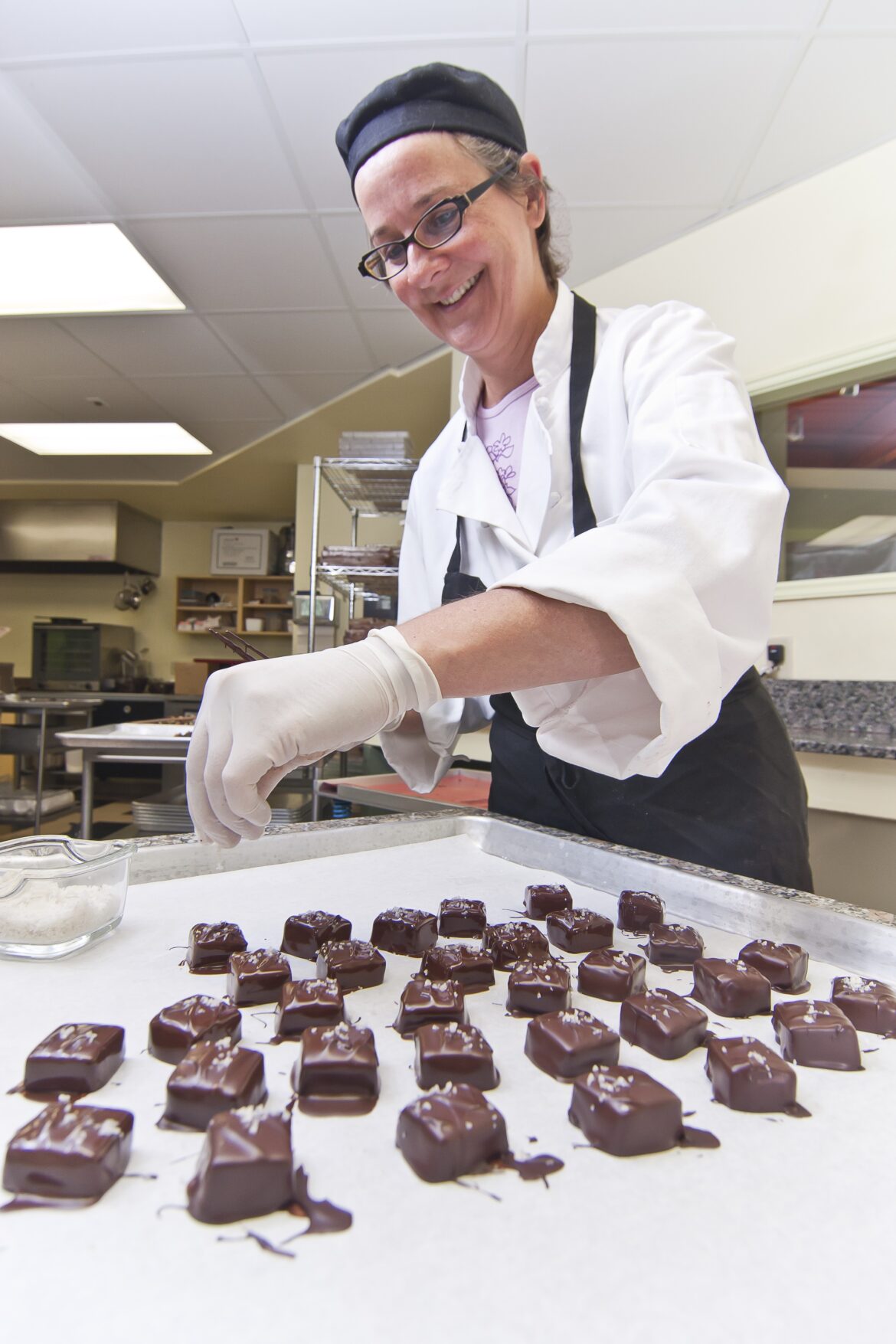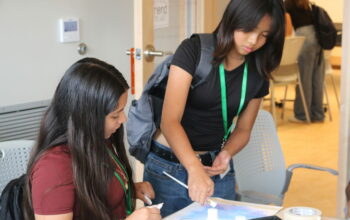You might be a little surprised to see a high-end, artisanal chocolate shop gracing the streets of a small city like Madison, but chocolatier Gail Ambrosius said she wouldn’t have it any other way.
Although she’s a Wisconsin native, Ambrosius honed her talents with classic Parisian training. Despite her killer résumé, she decided to come back to Wisconsin and open her shop in Madison.
“I never, ever thought about moving elsewhere,” Ambrosius said. “I think I’ve made a good business here by working hard and focusing on quality ingredients.”
Ambrosius, TK, said even though Madison is a small city, it’s her home, and Madisonians recognize and appreciate high-quality food.
Ambrosius’s chocolate business has been in operation since she opened in the Schenk-Atwood neighborhood on the east side of Madison in 2004. She said at her first location there wasn’t enough space for production and storage, but that she didn’t want to leave the neighborhood. When she was eventually able to move into a larger space right across the street, Ambrosius said she jumped at the chance.
“We carried all of our equipment over across the street in wagons,” she said.
Ambrosius came into the chocolate business a little later in life. After being laid off from her job as a cartographer with the State of Wisconsin, she decided it was her opportunity to finally pursue her passion. She said her fascination with artisan chocolate developed as a teenager, when she visited Paris with her high school’s French club, and that she’s always loved cooking.
She got her start in the industry with an online chocolatiering class from the École Chocolat in Vancouver, British Columbia. She then went back to France to learn from chocolatiers at Valrhona and Cluizel, two renowned French chocolate brands, for a short time.
Although she was trained in France, Ambrosius said she doesn’t rely exclusively on French methods. She said while most French artisans use machinery to coat their truffles in melted chocolate, her staff still dips them by hand.
“I don’t cut corners,” she said. “I like the way they look, and I think they taste better than the mechanized way.”
Ambrosius said enrobing her chocolates, which means coating them with a thin layer of chocolate, by hand takes longer and requires a larger staff, but that it’s all well worth it. She can almost always be found working alongside her employees to run the shop.
Lydia McGowan, who worked for Ambrosius when she was in high school, said she thinks this hands-on approach is what has made Ambrosius so successful.
“She’s an extremely dedicated person. She doesn’t half-ass anything, and she’s very centered in the whole process, rather than just being sort of like a removed-CEO type of boss,” McGowan said. “I think that’s really inspirational for a lot of business owners, especially in Madison since it’s such a tight-knit community.”
Ambrosius said she only uses dark chocolate, as she believes it has more flavor than lower percentages of chocolate. She said her shop does produce a few bonbons out of white chocolate and chocolate with lower cacao percentages, but that’s only a tiny percentage of her total production.
“Dark chocolate is better for you than milk chocolate, and more true to what cacao actually is,” Ambrosius said.
Ambrosius said recent discourse around heavy metals in dark chocolate has not impacted her sales.
“People ask questions, sure,” she said. “But that’s about it.”
Discovery of heavy metals such as lead and cadmium in dark chocolate have led to lawsuits filed against brands such as Trader Joe’s and Hersheys, according to articles from the Washington Post and USA Today. The metals occur naturally in soil, but because agriculture causes constant soil turnover, particles often end up floating around in the air, according to Bradley Bolling, Ph.D., a food scientist at UW. Bolling said some farming equipment used to be made of lead, which has added to levels in the soil.
“This issue is nothing new,” Bolling said, adding that lead and other heavy metals do not only occur in chocolate. “A very common example would be the high levels of mercury found in fish and seafood,” he said.
Although eating food with high levels of heavy metals is a concern and food production companies should take steps to lower those levels, the risk for heavy metal contamination is far greater if you live or work in a contaminated environment, according to Bolling.
Bolling referenced an assessment from the World Health Organization which concluded that cadmium intake from contaminated food like chocolate did not dangerously raise people’s cadmium levels.
According to the Food and Drug Administration, high levels of lead can also be found in many commercial fruits and vegetables. It’s also been found in baby food, according to a 2019 study from Healthy Babies Bright Futures, which found toxic heavy metals in 95% of the 168 baby foods tested.
Ambrosius said she thinks that since a lot of other foods also contain heavy metals, only fixating on and avoiding chocolate is misguided and counterproductive.
“I would be more concerned about other products we’re eating than the occasional chocolate indulgence,” she said.
Ambrosius said she is familiar with her origins of the cacao she uses, most of which is from Colombia. She has taken several trips to South America to learn more about sourcing and production of chocolate. She has a single-origin truffle made exclusively with cacao from an Ecuador-based cooperative she works closely with.
“Ecuador is a really fascinating country in that there are pockets all over the country where they grow chocolate and it all tastes different. They have very unique flavors,” Ambrosius said.
Despite her shop’s iconic fixture in Madison, Ambrosius’s business hit a snag in March 2020 when the COVID-19 pandemic hit. The shop temporarily closed that month and offered only curbside pickup for months. Ambrosius said not allowing customers into the store was difficult.
“In a span of two weeks we went from 18 employees to six,” Ambrosius said. “And all of the sudden, we had to adjust. No one could come into the shop.”
She said fortunately Madisonians were still eager to get their chocolate fix and to support local businesses, and sales didn’t slow much.
McGowan worked at Gail Ambrosius up until the pandemic hit and said she thinks the shop handled the crisis admirably.
“There was really good communication,” she said.
Like all the other unsalaried employees, she had to stop working that March while the shop was temporarily closed. She said while this was disappointing, she’s pleased to see the shop back in action and thriving.
Ambrosius said although the pandemic didn’t slow business and that the Madison community was incredibly supportive, she’s glad to have returned to business as usual.
“We’ve been really lucky in that sense,” she said.





